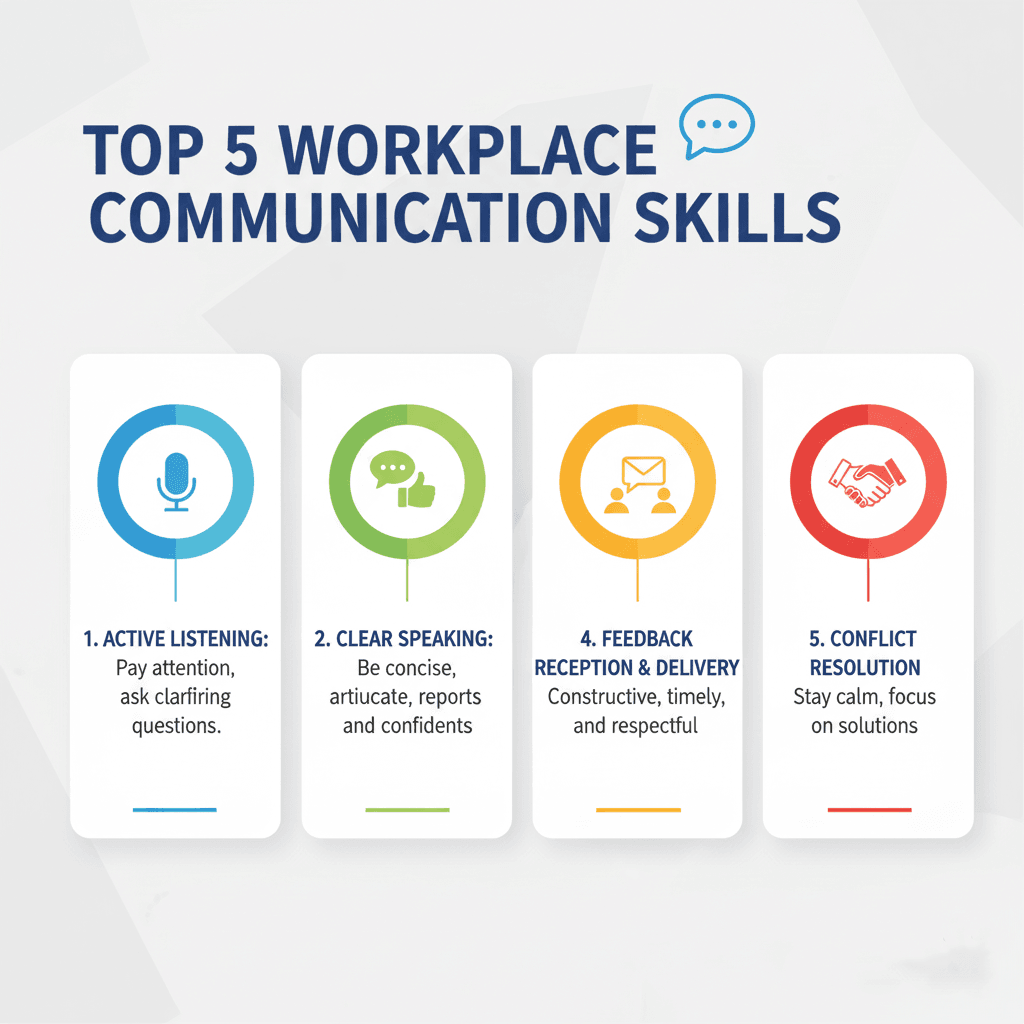5 Tips to Communicate Better at Work: Master Workplace Communication
Improve workplace communication with these 5 professional tips. Learn how to listen, adapt tone, write clearly, and communicate confidently with colleagues, clients, and managers.

Strong Communication = Career Success
Why Workplace Communication Matters
Workplace communication is more than just exchanging information—it’s the backbone of collaboration, efficiency, and professional growth. Whether you’re coordinating projects, giving presentations, or resolving conflicts, your communication skills shape how others perceive you and the outcomes of your work.
Effective workplace communication helps you:
Build trust and credibility with colleagues.
Minimize misunderstandings and conflicts.
Increase productivity and streamline processes.
Accelerate career growth and leadership opportunities.
In today’s fast-paced corporate environment, strong communication is no longer optional. Professionals who communicate clearly and confidently are often the ones who stand out, get promotions, and inspire teams.
Tip 1: Listen More Than You Speak
Many people equate communication with talking, but listening is just as important—if not more so. Active listening allows you to understand needs, spot issues early, and make better decisions.
Practical ways to improve listening at work:
Maintain eye contact during conversations or video calls.
Avoid interrupting or finishing someone else’s sentence.
Repeat back key points to confirm understanding:
“So you’re suggesting we move the deadline to next week?”
Take notes in meetings to remember details.
Example Scenario:
During a team meeting, a colleague explains a problem with the new software update. Instead of immediately giving a solution, you actively listen, ask clarifying questions, and confirm your understanding. Your colleague feels heard, and your proposed solution is more effective.
Clapingo Professional Tip: Make a conscious effort to listen 70% of the time and speak 30% in discussions.
Book a Clapingo demo session and practice real workplace conversations with expert mentors.
Experience the difference in just one call!
Tip 2: Be Clear and Concise
Clarity is key in workplace communication. Long-winded messages and overcomplicated explanations often lead to confusion, mistakes, and wasted time.
Tips for clearer communication:
Use short sentences and simple words.
Highlight key points using bullet points or numbered lists.
Avoid unnecessary jargon unless everyone is familiar with it.
Email Example:
❌ Long Email:
"I wanted to reach out to inform you that we might want to consider possibly reviewing the timeline for the current project in order to make adjustments if necessary."
✅ Clear Email:
"Let’s review the project timeline tomorrow to make adjustments."
Expanded Explanation:
When emails, reports, or presentations are concise, your audience can absorb information quickly, make decisions faster, and avoid misinterpretation.
Clapingo Professional Tip: Always ask yourself: Can this be communicated in fewer words without losing meaning?
Tip 3: Use the Right Tone
Your tone determines how your message is received. The same content can inspire teamwork or create tension depending on your delivery.
Tips for maintaining the right tone:
Be polite and respectful, even when addressing mistakes.
Avoid negative words or all caps in written communication.
Match your tone to the context: formal for reports, conversational for peer discussions.
Example:
❌ “You didn’t do this correctly.”
✅ “Here’s how we can improve this together.”
Clapingo Professional Tip: Before sending an email or speaking, ask yourself: Would I feel encouraged or criticized if I received this message?
Tip 4: Adapt to Your Audience
Different people require different communication styles. Adapting your message increases understanding and effectiveness.
Audience-based communication tips:
Manager: Be concise and solution-focused. Focus on outcomes.
Team member: Be collaborative, open to suggestions, and supportive.
Client: Be professional, reassuring, and clear about deliverables.
Scenario Example:
If your manager asks for a project update, highlight key metrics. If your teammate needs help, walk through steps and ask for input. If a client requests clarification, explain clearly and offer reassurance.
Clapingo Professional Tip: Ask yourself: Does this audience need details or just the main takeaway?
Tip 5: Use Technology Smartly
Digital tools are a double-edged sword. Emails, chat apps, and video calls increase efficiency—but can also create miscommunication.
Best practices for tech communication:
Email: Formal updates and documentation.
Chat: Quick clarifications and casual updates.
Video Call: Complex discussions, brainstorming, or sensitive topics.
Example Scenario:
Instead of sending a long text to explain a complicated issue, schedule a 10-minute video call. The visual cues and immediate feedback reduce misunderstandings.
Clapingo Professional Tip: Use emojis sparingly in casual chats to convey tone, but keep formal communication professional.
Clapingo: Practice Makes Perfect
Many professionals struggle with communication not because they lack knowledge, but because they lack practice in real scenarios.
Clapingo provides:
Role-play sessions for meetings, feedback, and presentations.
Personalized guidance to improve clarity, tone, and confidence.
Real-time corrections and fluency improvement exercises.
Practicing with mentors ensures you’re prepared for high-stakes conversations at work.
Make Communication Stick

How To Improve Workplace Communication
Tip 6: Master Non-Verbal Communication
Your body language, facial expressions, and gestures convey more than words.
Tips:
Maintain open posture.
Smile to appear approachable.
Nod to show engagement.
Avoid crossing arms during discussions.
Scenario: A manager notices you nodding and taking notes during a presentation—you appear engaged and trustworthy.
Tip 7: Handle Conflicts Professionally
Misunderstandings happen—strong communicators manage conflicts calmly.
Steps to resolve conflict:
Listen actively.
Restate concerns objectively.
Suggest solutions, not blame.
Follow up to ensure resolution.
Example: Instead of saying, “You messed up the report”, try: “I noticed some discrepancies in the report. Can we review and correct them together?”
Tip 8: Ask Questions To Clarify
Questions show engagement and reduce mistakes.
Types of questions:
Open-ended: “How do you envision this project working?”
Clarifying: “Do you mean the deadline is Friday or next Monday?”
Probing: “What challenges do you anticipate with this plan?”
Clapingo Professional Tip: Always ask questions before making assumptions.
Tip 9: Follow-Up Communication
Following up is critical in workplace communication. It reinforces accountability and clarity.
Example:
After a meeting, send a quick summary:
"Summary of our discussion: Action items for next week – [list items]. Please confirm or add if anything is missing."
Tip 10: Practice Empathy In Conversations
Empathy improves workplace relationships. Understand the perspective of your audience.
Tips:
Listen without judgment.
Validate feelings: “I understand this is challenging.”
Adjust communication to reduce stress or confusion.
Tip 11: Email & Message Best Practices
- Use subject lines that summarize content.
- Keep paragraphs short.
Highlight action items in bold or bullet points.
Proofread for spelling and grammar.
Tip 12: Public Speaking at Work
Even small presentations count as workplace communication.
Tips:
Start with a strong opening.
Maintain eye contact.
Practice tone and pauses.
Invite questions to keep audience engaged.
Clapingo Tip: Practice presentations with mentors for fluency and confidence.

Workplace Communication Tips
Tips & Tricks Infographic
Do’s: ✅
Listen actively.
Keep messages short.
Adjust tone to audience.
Clarify when unsure.
Follow up on discussions.
Don’ts: ❌
Interrupt colleagues.
Overcomplicate emails.
Use harsh language.
Assume understanding.
Ignore follow-ups.
Did You Know?
70% of workplace mistakes are caused by poor communication.
Employees with strong communication skills are 25% more likely to get promoted.
Non-verbal cues account for over 60% of how messages are interpreted.
Effective Meeting Communication
Meetings are a core part of workplace communication. Clear communication in meetings ensures everyone is aligned and productive.
Tips:
Set a clear agenda in advance.
Speak concisely and stick to key points.
Encourage participation by asking open-ended questions.
Summarize action items at the end.
Example: A weekly project meeting can avoid confusion if each participant leaves knowing their tasks, deadlines, and responsibilities.

How To Improve Workplace Communication In Meetings
Communicating Across Cultures
In today’s global workplaces, cultural sensitivity is crucial. Misunderstandings can arise from different communication styles.
Tips:
Avoid slang or idioms that may confuse international colleagues.
Be aware of cultural norms regarding tone, gestures, and humor.
Ask questions politely if unsure about expectations.
Example: While a direct style may work in some cultures, a more diplomatic tone may be needed in others.
Storytelling at Work
Storytelling is a powerful tool for engaging your audience and making complex ideas memorable.
Tips:
Start with a context or challenge.
Explain actions or solutions.
End with the results and key takeaway.
Scenario: Presenting quarterly results: instead of just numbers, tell a story of challenges, solutions, and outcomes to engage your team.
Email Etiquette Best Practices
Emails are still one of the most common workplace communication tools. Poor email etiquette can create friction.
Tips:
Use professional salutations.
Keep subject lines informative.
Avoid unnecessary CCs and BCCs.
Proofread before sending.
Example: A clear email saves hours of back-and-forth clarification.
Using Feedback Effectively
Feedback is essential for growth. Both giving and receiving feedback requires communication skills.
Tips for giving feedback:
Be specific and constructive.
Focus on actions, not personality.
Suggest improvements and offer support.
Tips for receiving feedback:
Listen without interruption.
Ask clarifying questions.
Take notes and follow up.
Communication During Remote Work
Remote communication has unique challenges, from misinterpreted tone to lack of non-verbal cues.
Tips:
Over-communicate important updates.
Use video calls for sensitive discussions.
Set clear expectations for response times.
Use collaborative tools (Slack, Trello, Teams) effectively.
Example: A team working remotely can avoid confusion by documenting decisions and assigning responsibilities clearly.
Emotional Intelligence in Communication
Emotional intelligence (EQ) is key to understanding and managing both your emotions and others’.
Tips:
Recognize your emotions before reacting.
Consider colleagues’ perspectives.
Manage stress during difficult conversations.
Example: During conflict, staying calm and empathetic leads to constructive solutions rather than escalation.
Presentation Skills
Presenting ideas clearly to a group requires both verbal and non-verbal communication.
Tips:
Start with a hook or story.
Use visuals to simplify complex ideas.
Maintain eye contact and confident posture.
Invite questions to foster interaction.
Example: A strong presentation to clients can build trust and lead to better business outcomes.
Listening to Non-Verbal Cues
Non-verbal communication can provide context and insight beyond words.
Tips:
Observe body language, facial expressions, and tone.
Note inconsistencies between words and actions.
Adjust your approach based on cues.
Example: If a team member seems disengaged in a meeting, a follow-up conversation can uncover concerns and prevent issues.

How To Improve Workplace Communication & Teamwork
Building Communication Habits
Effective communication is a habit, not a one-time skill.
Tips:
Practice clarity daily in emails and conversations.
Keep a communication journal to track improvements.
Seek feedback from mentors or colleagues.
Role-play scenarios to reinforce learning.
Clapingo Professional Tip: Consistent practice builds confidence and fluency, making workplace communication second nature.
Conclusion
Effective workplace communication is a skill you can learn and master. By combining listening, clarity, appropriate tone, audience adaptation, and smart technology use, you’ll build stronger relationships, avoid misunderstandings, and accelerate your career.
Practicing with mentors on Clapingo ensures you apply these tips confidently in real-world scenarios. Strong communicators aren’t born—they practice, reflect, and improve every day.
Read Now
Workplace English: 10 Best Communication Skill Tips for Career Success
Business English: 10 Tips on How To Give Great Presentations at Work
How to Negotiate Salary in English - Smart Negotiation Tips for Success
Comments
Your comment has been submitted successfully!